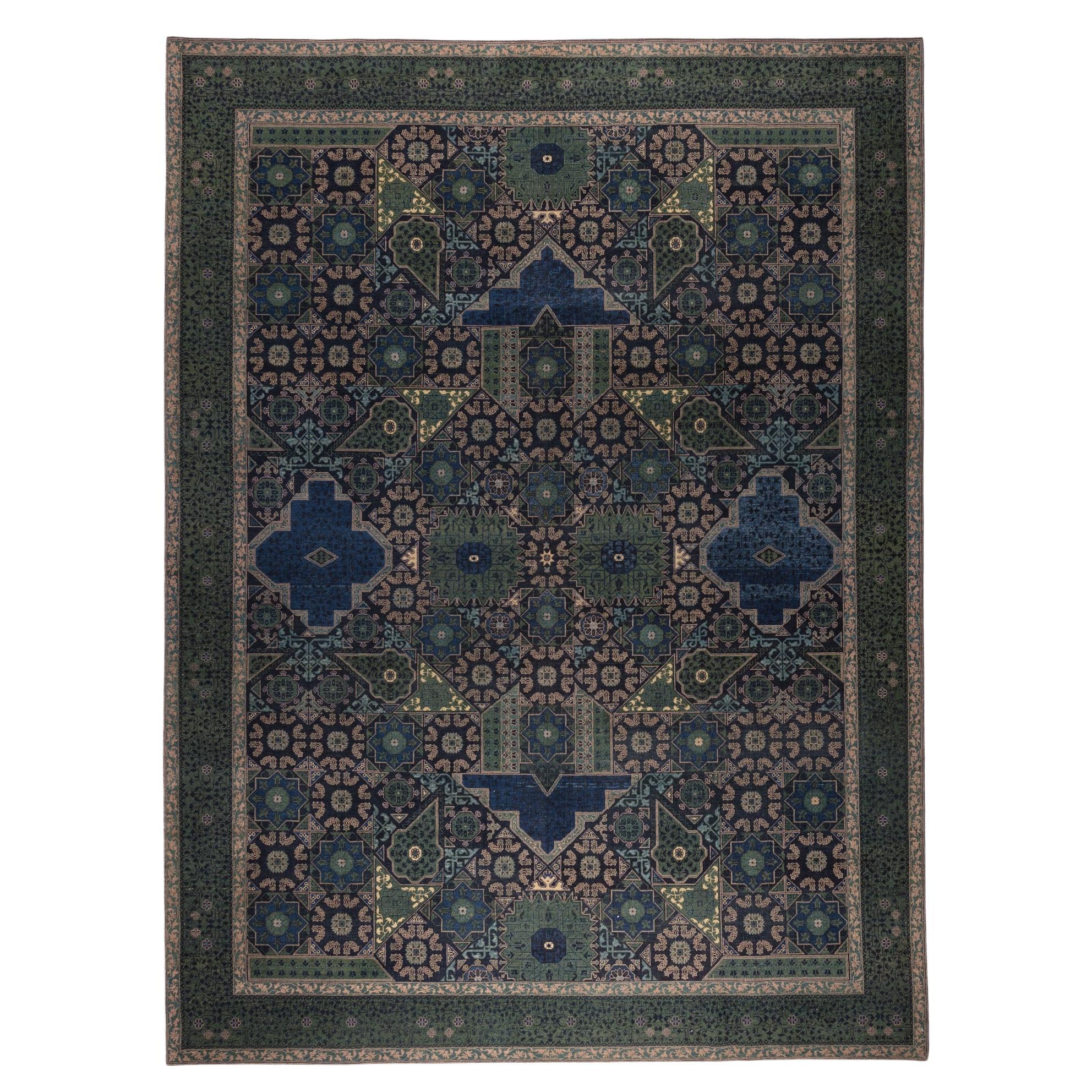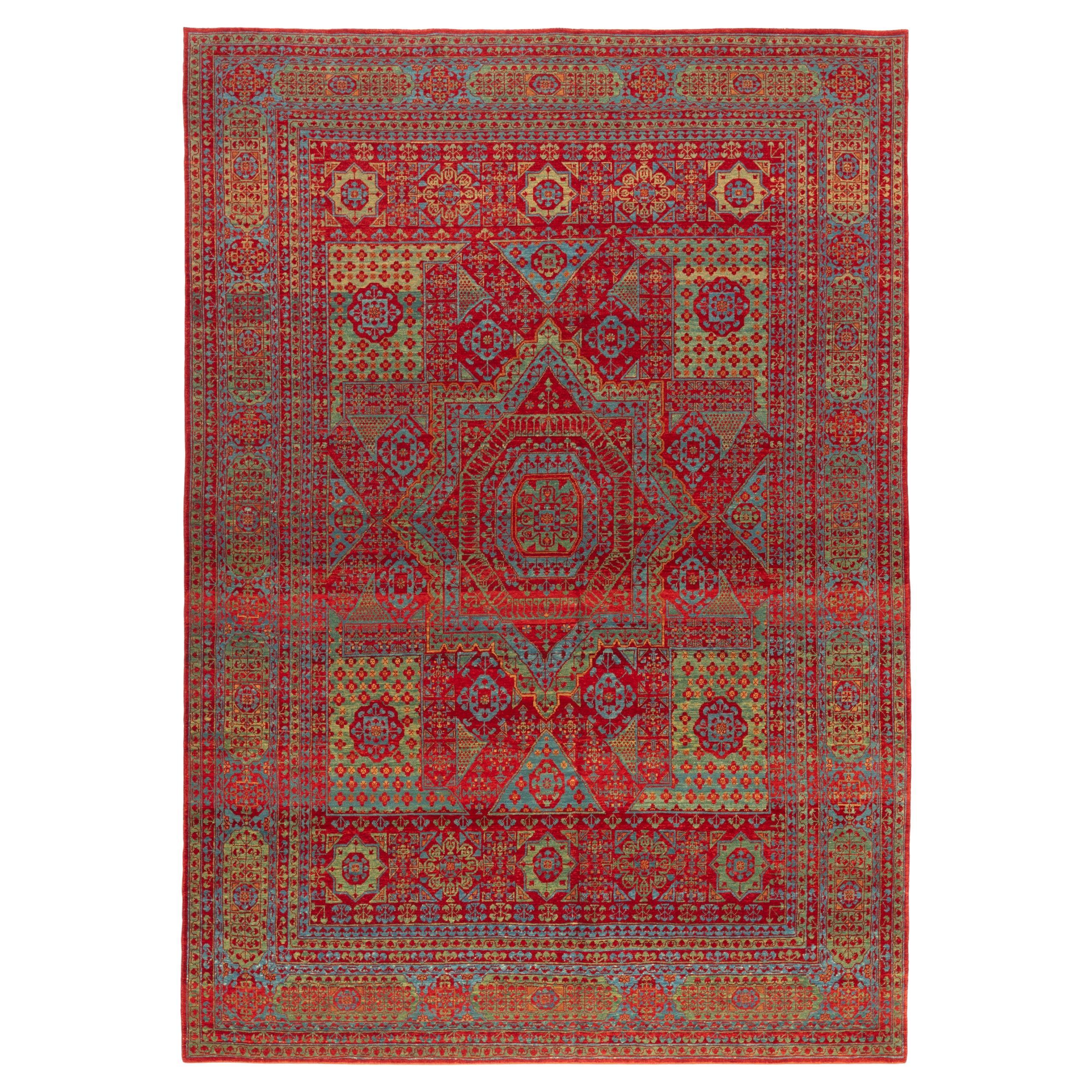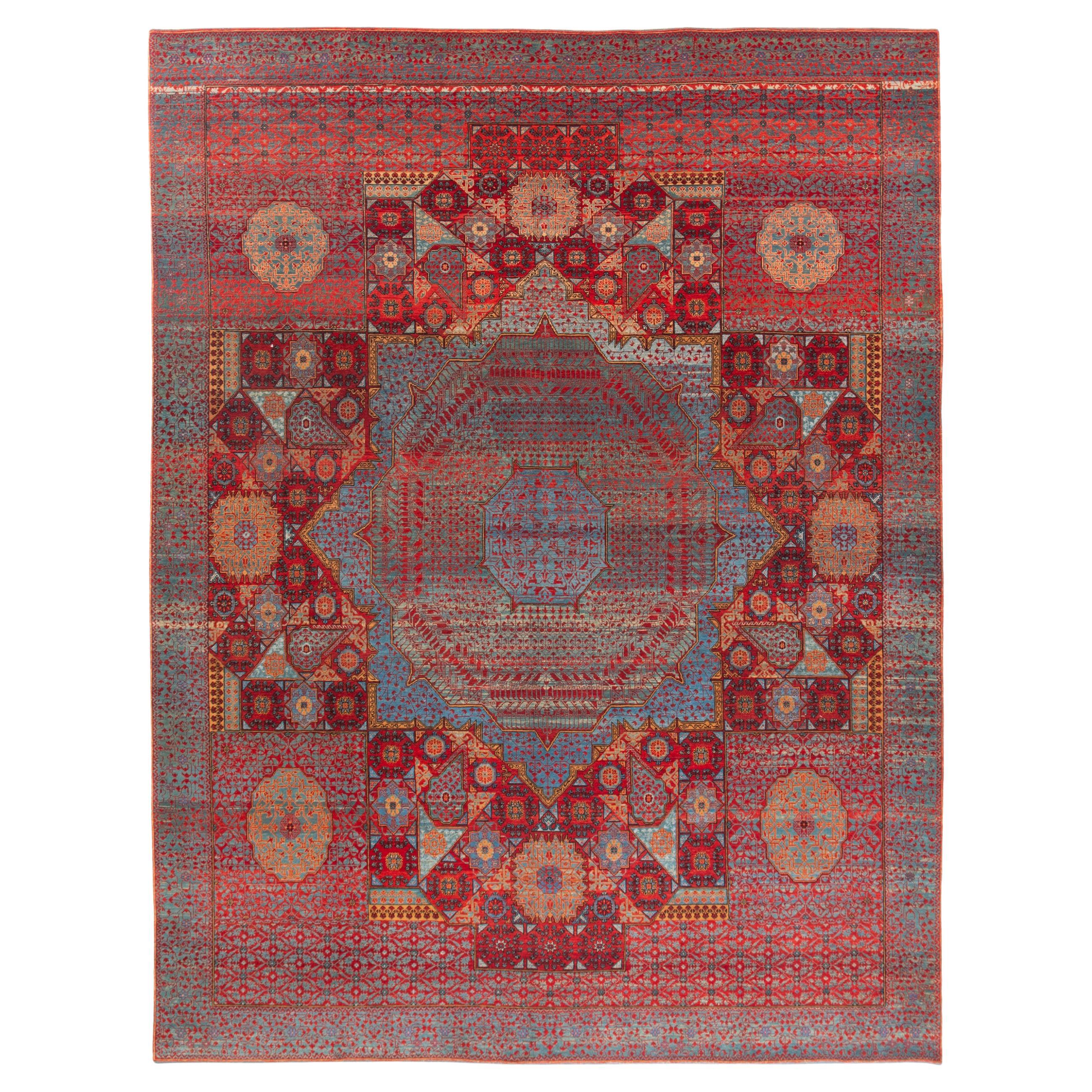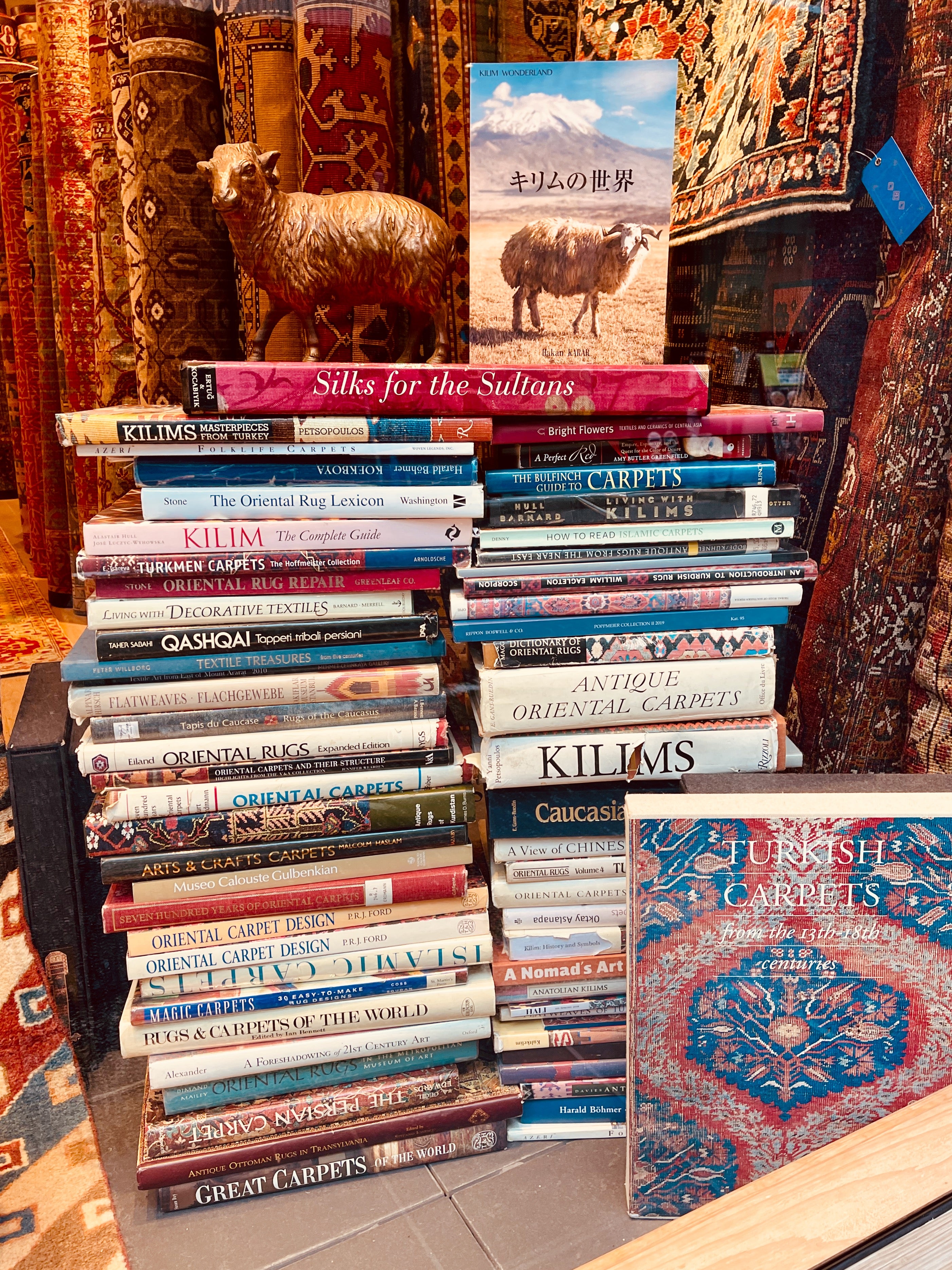Items Similar to Ararat Rugs Mamluk Rug with Large Octagon 16th Cen. Antique Egypt Revival Carpet
Want more images or videos?
Request additional images or videos from the seller
1 of 10
Ararat Rugs Mamluk Rug with Large Octagon 16th Cen. Antique Egypt Revival Carpet
About the Item
The design source of the rug comes from the book Renaissance of Islam, Art of the Mamluks, Esin Atil, Smithsonian Institution Press, Washington D.C., 1981 nr.128. This rug with a large central octagon was designed in the early 16th-century rug by Mamluk Sultane of Cairo, Egypt. It is exhibited at the Washington D.C. The Textile Museum, R.16.2.8. This example represents a stylistic development in the almost square Mamluk rug with a tripartite field and wide border. The rectangular bands above and below the central unit are narrower (one-sixth the height of the central unit) and create a slightly elongated center in contrast to the square format seen earlier; the border has a continuous pattern, which disregards the compartmentalized design. This features together with the addition of ivory and yellow to the traditional red, green, and blue-suggest that the rug is later in date than the others. However, the employment of a concentric octagon as the main theme and the abundant use of floral motifs based on papyrus plants are traditional and follow the stylistic and decorative features of Mamluk rugs. The nearly square central unit is almost completely covered by a large octagon with blue papyrus sprays on red ground. In the center of each side is an eight-lobed medallion attached by a stem to an inner octagon. This octagon, filled with green lancet leaves on a red ground, encloses another identical element, decorated with red papyrus motifs on a green ground. Inside is a fourth octagon with an ivory medallion, its radiating flames rendered in yellow. In the center of the medallion is an eight-pointed star enclosing a minute octagon with a six-petaled rosette. The corner triangles have red papyrus sprays placed around octagonal units with yellow rosettes. Two scrolls of stylized lotus blossoms join the triangles at the top and bottom. The transverse bands have additional papyrus motifs intermingled with heart-shaped motifs, split leaves, and blossoms, rendered in red on green ground. A chevron band encircles the transverse bands; thin strips, filled with papyrus leaves, run vertically between the bands along the outer edges. The border, executed in blue with touches of yellow on a red ground, displays an enlarged version of the motifs used in the transverse bands. Floral scrolls adorn the double guard borders: one has a blue papyrus on a red ground, and the other shows blue and red leaves on a yellow ground. The dynamism of the radiating units, evolving from an ivory core enclosed by a golden halo, creates a kaleidoscopic effect with brilliantly colored rings unequaled in any rug tradition. The elements evolve from an almost microscopic core and increase in size as they move outward. A similar centrifugal force is observed in illuminations of the Koran and can be interpreted as having cosmic implications and symbolizing celestial light. The color scheme of this carpet recalls the red, blue, green, and yellow stained-glass windows that burst into jewellike tones when lit by sunlight. Light is also an important factor in Mamluk rugs, for their appearance and design change as the rays of the sun and flicker of oil lamps play upon their surfaces. The design of the rug is interpreted by our designers, and the most appropriate colors to match the original are used for this rug.
Color summary: 4 colors in total;
Falu Red 416 (Madder Root)
Pale Green 439 (Chamomile – Indigo)
Sunray Color 405 (Henna)
Dusty Turquoise 340 (Spurge – Madder Root – Indigo – Walnut Husk)
Group: Islamic Rugs Family
Area: Mamluk
Material of Pile: Natural Dyed Hand-spun Wool
Material Warp / Weft: Wool on Wool
Structure: Symmetrical knot on depressed warp inclining to the right
Knots Density: 39x39
Production Place: DERVİŞ HASAN
Stock Location: Tokyo
Size (EU): 197 X 158cm
Size (US): 6'5" X 5'2"
Area (EU): 3.1m²
Area (US): 33.5ft²
- Creator:Ararat Rugs (Manufacturer)
- Dimensions:Width: 62.21 in (158 cm)Length: 77.56 in (197 cm)
- Style:Revival (In the Style Of)
- Materials and Techniques:
- Place of Origin:
- Period:
- Date of Manufacture:2023
- Production Type:New & Custom(One of a Kind)
- Estimated Production Time:Available Now
- Condition:
- Seller Location:Tokyo, JP
- Reference Number:1stDibs: LU8206235053422
ARARAT RUGS
We know and believe that the geography we come from, our past, and our lifestyle are the most important bond between us to carry the oriental carpet art and culture to the next generations along with our core values in our ongoing growth journey.
We are aware that the way to achieve this goal and carry this priceless art and culture to the future depends on a lot of work with all our people every day while adhering to our core values.
For us, art is meaningful in the sense that it brings together various cultures around the world. It is an honor for us that oriental carpet art and culture have been instrumental in this for centuries and that we are a part of this business.
We are tirelessly keeping an eye on auction house information around the world about carpets. New York's Metropolitan, London's Victoria & Albert Museums, and other famous art museums, as well as small specialized museums that house private collections, and books about oriental carpets to collect information on outstanding carpet designs and patterns from around the world. It's our Self-improving and Self-developing culture.
As Turkish Culture of Hospitality, the Kurdish Culture of Generosity, and as Japanese Culture of Business Punctuality; are the most important values that this multicultural background has taught and bequeathed to us. It is essential and valuable for us that you feel this feeling not only by looking at our oriental carpets but from the moment you contact us.
About the Seller
5.0
Gold Seller
These expertly vetted sellers are highly rated and consistently exceed customer expectations.
Established in 1970
1stDibs seller since 2023
12 sales on 1stDibs
Typical response time: 1 hour
- ShippingRetrieving quote...Ships From: Tokyo, Japan
- Return PolicyA return for this item may be initiated within 7 days of delivery.
More From This SellerView All
- Ararat Rugs Mamluk Carpet, 16th Century Antique Revival Rug, Natural DyedBy Ararat RugsLocated in Tokyo, JPThe source of the rug comes from the book Völker, Angela, Die orientalischen Knüpfteppiche das MAK, Vienna: Böhlau, 2001: 42–5. This rug with the central star was designed in the early 16th century rug by Mamluk Sultane of Cairo, Egypt. It is exhibited at MAK – Museum of Applied Arts, Vienna Austria. As its impressive size, materials, and design quality suggest, the carpet is a product of an accomplished court workshop and likely dates from the late period of the last Mamluk dynasty. The quantity of the colors used speaks for an earlier date around 1500; the delicate vegetal border with leaf tendrils and the characteristic umbrella leaves...Category
21st Century and Contemporary Turkish Revival Turkish Rugs
MaterialsWool, Natural Fiber, Organic Material
- Ararat Rugs Mamluk Rug with Central Star, 16th C. Revival Carpet, Natural DyedBy Ararat RugsLocated in Tokyo, JPThe source of the rug comes from the Textile Museum, Washington D.C. inv. R 16.2.4. This rug with the central star was designed in the early 16th-century rug by Mamluk Sultane of Cai...Category
21st Century and Contemporary Turkish Revival Turkish Rugs
MaterialsWool, Natural Fiber, Organic Material
- Ararat Rugs Mamluk Carpet with Central Star 16th Century Revival, Natural DyedBy Ararat RugsLocated in Tokyo, JPThe source of the rug comes from the book Völker, Angela, Die orientalischen Knüpfteppiche das MAK, Vienna: Böhlau, 2001: 42–5. This rug with the central star was designed in the early 16th-century rug by Mamluk Sultane of Cairo, Egypt. It is exhibited at MAK – Museum of Applied Arts, Vienna Austria. As its impressive size, materials, and design quality suggest, the carpet is a product of an accomplished court workshop and likely dates from the late period of the last Mamluk dynasty. The quantity of the colors used speaks for an earlier date around 1500; the delicate vegetal border with leaf tendrils and the characteristic umbrella leaves...Category
21st Century and Contemporary Turkish Revival Turkish Rugs
MaterialsWool, Natural Fiber, Organic Material
- Ararat Rugs Mamluk Carpet with Central Star 16th Century Revival, Natural DyedBy Ararat RugsLocated in Tokyo, JPThe source of the rug comes from the book Völker, Angela, Die orientalischen Knüpfteppiche das MAK, Vienna: Böhlau, 2001: 42–5. This rug with the central star was designed in the early 16th-century rug by Mamluk Sultane of Cairo, Egypt. It is exhibited at MAK – Museum of Applied Arts, Vienna Austria. As its impressive size, materials, and design quality suggest, the carpet is a product of an accomplished court workshop and likely dates from the late period of the last Mamluk dynasty. The quantity of the colors used speaks for an earlier date around 1500; the delicate vegetal border with leaf tendrils and the characteristic umbrella leaves...Category
21st Century and Contemporary Turkish Revival Turkish Rugs
MaterialsWool, Natural Fiber, Organic Material
- Ararat Rugs Mamluk Carpet with Central Star 16th Century Revival, Natural DyedBy Ararat RugsLocated in Tokyo, JPThe source of the rug comes from the book Völker, Angela, Die orientalischen Knüpfteppiche das MAK, Vienna: Böhlau, 2001: 42–5. This rug with the central star was designed in the early 16th-century rug by Mamluk Sultane of Cairo, Egypt. It is exhibited at MAK – Museum of Applied Arts, Vienna Austria. As its impressive size, materials, and design quality suggest, the carpet is a product of an accomplished court workshop and likely dates from the late period of the last Mamluk dynasty. The quantity of the colors used speaks for an earlier date around 1500; the delicate vegetal border with leaf tendrils and the characteristic umbrella leaves...Category
21st Century and Contemporary Turkish Revival Turkish Rugs
MaterialsWool, Natural Fiber, Organic Material
- Ararat Rugs Mamluk Carpet with Central Star 16th Century Revival - Natural DyedBy Ararat RugsLocated in Tokyo, JPThe source of the rug comes from the book Völker, Angela, Die orientalischen Knüpfteppiche das MAK, Vienna: Böhlau, 2001: 42–5. This rug with the central star was designed in the early 16th-century rug by Mamluk Sultane of Cairo, Egypt. It is exhibited at MAK – Museum of Applied Arts, Vienna Austria. As its impressive size, materials, and design quality suggest, the carpet is a product of an accomplished court workshop and likely dates from the late period of the last Mamluk dynasty. The quantity of the colors used speaks for an earlier date around 1500; the delicate vegetal border with leaf tendrils and the characteristic umbrella leaves...Category
21st Century and Contemporary Turkish Revival Turkish Rugs
MaterialsWool, Natural Fiber, Organic Material
You May Also Like
- Carpet with the pattern of ancient Mamluk carpets and light shadeLocated in Firenze, ITImportant contemporary production carpet made entirely by hand in Turkey, which is inspired by the famous "Mamluk" carpets. Mamluks are called Egyptian-made carpets, probably from Ca...Category
2010s Turkish Moorish Turkish Rugs
MaterialsWool
- Antique Large Persian Serapi Carpet Rug, 19th CenturyLocated in San Francisco, CAAntique Large Persian Serapi Carpet Rug, 19th Century This exceptionally elegant Serapi carpet from Northwest Persia draws a central medallion within a square-shaped field. A centra...Category
Antique 19th Century Persian Persian Rugs
MaterialsWool
- Rare 16th Century Cairene RunnerLocated in New York, NYAuthentic 16th century Cairene runner Size: 3'0" × 13'1" (91 × 398 cm) A 16th century Cairene antique runner, the abrashed dusty rose field with stylized leaves and rosettes overall around a column of cusped medallions with crosses at each end and containing a floral branch within an ivory rosette border. Woven in Egypt under imperial Ottoman...Category
Antique 16th Century Egyptian Turkish Rugs
MaterialsWool
- Star Kazak Original 16th Century Style Flatweave Rug by Knots RugsLocated in London, GBCOLOUR: Original MATERIAL: 100% Wool QUALITY: 23 x 39 Persian knot / inch ORIGIN: Persian knotted rug produced in Afghanistan RUG SIZE DISPLAYED: 128cm x 191cm Inspired by an or...Category
21st Century and Contemporary Afghan Turkish Rugs
MaterialsWool
- Large Handmade Carpet Antique Mahal Persian Rug Mashayekh Square CarpetLocated in Hampshire, GBThis large handmade Mashayekh square carpet is a timeless masterpiece crafted with utmost precision and care. Dating back to the 1880s, this rug carries a rich history and unrivaled ...Category
Antique Late 19th Century Persian Turkish Rugs
MaterialsCotton
- Antique 19th Century Large Carpet Tabriz Rug wool hand knottedLocated in Berlin, DERare, large Tabriz carpet. Size: 380 cm x 300 cm.Category
Antique 19th Century Egyptian Islamic Persian Rugs
MaterialsWool






